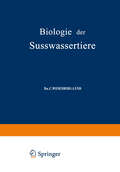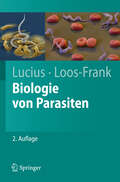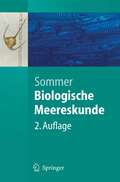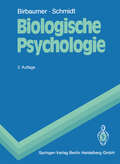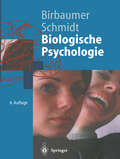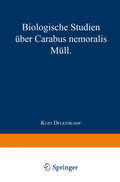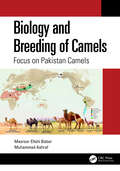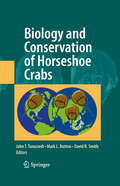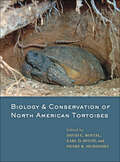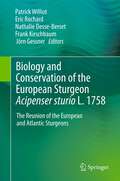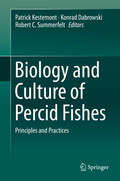- Table View
- List View
Biologie der Süsswasserinsekten
by Carl Wesenberg-LundDieser Buchtitel ist Teil des Digitalisierungsprojekts Springer Book Archives mit Publikationen, die seit den Anfängen des Verlags von 1842 erschienen sind. Der Verlag stellt mit diesem Archiv Quellen für die historische wie auch die disziplingeschichtliche Forschung zur Verfügung, die jeweils im historischen Kontext betrachtet werden müssen. Dieser Titel erschien in der Zeit vor 1945 und wird daher in seiner zeittypischen politisch-ideologischen Ausrichtung vom Verlag nicht beworben.
Biologie der Süsswassertiere: Wirbellose Tiere
by C. Wesenberg-Lund O StorchDieser Buchtitel ist Teil des Digitalisierungsprojekts Springer Book Archives mit Publikationen, die seit den Anfängen des Verlags von 1842 erschienen sind. Der Verlag stellt mit diesem Archiv Quellen für die historische wie auch die disziplingeschichtliche Forschung zur Verfügung, die jeweils im historischen Kontext betrachtet werden müssen. Dieser Titel erschien in der Zeit vor 1945 und wird daher in seiner zeittypischen politisch-ideologischen Ausrichtung vom Verlag nicht beworben.
Biologie des Geistesblitzes - Speed up your mind!
by Henning BeckDenken Sie, das Gehirn ist eine perfekte Rechenmaschine, die evolutionäre Krone aller Informationssysteme, die komplexeste Struktur des Universums, präziser und leistungsfähiger als jeder Computer? Vergessen Sie das sofort! Das Gehirn ist ein Haufen voller eitler, fauler und selbstverliebter Zellen, die sich ständig verrechnen und dabei noch permanent von ihren Nachbarn abgelenkt werden.Da hält man es kaum für möglich und doch geschieht das Wunder: Das Gehirn funktioniert! Sehr gut sogar, denn Menschen sind im Gegensatz zu rechnenden Maschinen ausgesprochen kreativ.„Wie das?“, mag man fragen und dieses Buch gibt die Antwort darauf. Fachlich fundiert und locker aufbereitet berichtet der deutsche Science Slam-Meister 2012 Henning Beck über das Zusammenspiel von Nerven- und ihren Helferzellen, erklärt, was ein Geistesblitz überhaupt ist, wie er entsteht und was die Hirnforschung zum Thema Kreativität zu sagen hat.
Biologie von Parasiten (Springer-Lehrbuch)
by Richard Lucius Brigitte Loos-FrankInfektionserreger der besonderen Art: Malaria, Schlafkrankheit, Würmer und Zecken. Die Autoren bieten auf Grundlage der aktuellen Systematik eine Übersicht über die Biologie parasitärer Einzeller, Würmer und Arthropoden. In Querschnittskapiteln sprechen sie die Besonderheiten der parasitischen Lebensweise an. Am Beispiel typischer Vertreter stellen sie die Lebenskreisläufe und immunologische sowie molekulare Aspekte dar. Sie behandeln sowohl die Krankheiten der Tiere als auch die des Menschen. Anschauliche Abbildungen ergänzen den Text. Eine weitere wertvolle Ergänzung sind die klinischen Bilder der Krankheiten sowie Prüfungsfragen am Ende eines jeden Kapitels. Mit diesem Lehrbuch sind Sie gut gerüstet!
Biologie von Parasiten (Springer-Lehrbuch)
by Richard Lucius Brigitte Loos-Frank Richard P. LaneDie 3. vollständig überarbeitete Auflage dieses Buches führt in die Biologie parasitärer Einzeller, Würmer und Arthropoden ein. Im einführenden Kapitel stellen die Autoren Konzepte der Parasitologie vor. Ausführlich gehen sie dann auf wichtige Infektionserreger, wie die der Malaria, der Toxoplasmose oder von Wurminfektionen ein, wobei die molekularen Aspekte ihrer Biologie erläutert werden. Außerdem werden Parasiten als Krankheitsüberträger dargestellt und wichtige Parasitosen, die bei Tieren vorkommen, besprochen. Daher wendet sich dieses Buch sowohl an Biologen, als auch an Veterinärmediziner und Mediziner. In den einzelnen Kapiteln kommen die Anpassungen an die parasitische Lebensweise zur Sprache. Anhand häufiger Vertreter werden exemplarisch typische Lebenszyklen, die Immunreaktionen und die resultierenden Krankheitsbilder erklärt. Viele Abbildungen veranschaulichen dabei den Text. Die Prüfungsfragen am Ende eines jeden Kapitels helfen, den Lerninhalt zu rekapitulieren und zu verinnerlichen.
Biologische Meereskunde (Springer-Lehrbuch)
by Ulrich SommerDas Meer ist der größte Lebensraum der Erde - hier hat die Evolution der Organismen begonnen, und hier findet sich auch die größte Vielfalt organismischer Baupläne. Lernfreundlich aufbereitet und leicht verständlich geschrieben, gibt das Lehrbuch einen grundlegenden und umfassenden Überblick über die verschiedenen Lebensräume und Lebensgemeinschaften des Meeres. Ökologische Prozesse wie Konkurrenz, Fressbeziehungen, Symbiosen und Nahrungsnetze sind zentrale Themen. Zahlreiche Abbildungen regen zum Lesen und Lernen an.
Biologische Psychologie (Springer-Lehrbuch)
by Niels Birbaumer Robert F. SchmidtDer große Erfolg machte bereits nach kurzer Zeit eine Neuauflage notwendig. Die verbesserte 2. Auflage bietet eine übersichtliche und umfassende Einführung in die biologischen und physiologischen Grundlagen des Verhaltens: Von der Einzelzelle bis zu den Denkprozessen wird der neueste Wissensstand dargestellt. Das Gehirn wird dabei nicht nur als biologische Größe betrachtet, die psychisches Erleben und Verhalten "hervorbringt", sondern als ein in ständigem Austausch mit den Umweltgegebenheiten und den vererbten Eigenschaften befindliches dynamisches System. Die didaktisch übersichtliche Darstellung mit zahlreichen hervorragenden Abbildungen erleichtert sowohl dem Anfänger den Einstieg als auch dem Fortgeschrittenen die Aktualisierung seines Wissens. Das Buch ermöglicht somit nicht nur eine ökonomische Prüfungsvorbereitung, sondern führt den Leser zu einem Verständnis des komplexen Zusammenwirkens physiologischer Gesetzmäßigkeiten mit Verhaltensprinzipien.
Biologische Psychologie (Springer-Lehrbuch)
by Niels Birbaumer Robert F. SchmidtDas erfolgreiche Lehrbuch bietet eine umfassende Einführung in die biologischen Grundlagen des Verhaltens. Von der Einzelzelle bis zu den Denkvorgängen des Menschen wird der neueste Wissenstand dargestellt. Das Gehirn wird dabei nicht nur als biologische Größe betrachtet, die psychische Prozesse hervorbringt, sondern als ein in ständigem Austausch mit den Umweltgegebenheiten und den vererbten Eigenschaften befindliches dynamisches System. Das Buch besticht durch seine systematische Gliederung und konsequente Didaktik. Jedes Kapitel enthält Einleitungen, strukturierende Überschriften und knappe Zusammenfassungen der wesentlichen Lerninhalte. Somit ermöglicht es nicht nur eine ökonomische Prüfungsvorbereitung, sondern führt den Leser zu einem Verständnis des komplexen Zusammenwirkens von Verhaltensprinzipien und physiologischen Gesetzmäßigkeiten.
Biologische Studien über Carabus nemoralis Müll: Von dem Senat der Landwirtschaftlichen Hochschule in Berlin genehmigte Dissertation zur Erlangung der Würde eines Doktors der Landwirtschaft
by Kurt DelkeskampDieser Buchtitel ist Teil des Digitalisierungsprojekts Springer Book Archives mit Publikationen, die seit den Anfängen des Verlags von 1842 erschienen sind. Der Verlag stellt mit diesem Archiv Quellen für die historische wie auch die disziplingeschichtliche Forschung zur Verfügung, die jeweils im historischen Kontext betrachtet werden müssen. Dieser Titel erschien in der Zeit vor 1945 und wird daher in seiner zeittypischen politisch-ideologischen Ausrichtung vom Verlag nicht beworben.
Biologisches Design: Systematischer Katalog für bionisches Gestalten
by Werner NachtigallMit diesem Nachschlagewerk wird eine systematische Katalogisierung der Lösungen angeboten, die dem Designer oder Konstrukteur einen großen Fundus zur kreativen Umsetzung in der Technik liefert.
Biology and Breeding of Camels: Focus on Pakistan Camels
by Masroor Ellahi Babar Muhammad AshrafThis book discusses the biology, breeding, care, and management of camels, with a focus on camels from Pakistan. The book provides a sound understanding of how to look after camels, their senses, behavior, and adaptations. The chapters describe the practical aspects of camel husbandry such as how to maintain their body condition, feet, and cleanliness. It covers the types of feeds, feeding methods, and their needs at different stages of life. The book provides a detailed account of camel husbandry, breeding, and reproduction. It is meant for camel breeders, veterinarians, livestock advisers, students, and researchers working on animal sciences, camel rearing, feeding, and management.FEATURES Includes information about different species of camels present in Pakistan and their importance to humans Discusses the nutrition and feeding of camels, the medicinal qualities of camel milk, and the peculiar immunity-enhancing properties of their nutritious meat Describes the features of camels that help them survive and thrive in deserts and make them the animals of the future Covers the range of unique products obtained from camels and their economic value Explores the management, types of diseases in camels, causes of their spread, their control, and therapeutic measures for successful and productive farming
Biology and Breeding of Camels: Focus on Pakistan Camels
by Masroor Ellahi Babar Muhammad AshrafThis book discusses the biology, breeding, care, and management of camels, with a focus on camels from Pakistan. The book provides a sound understanding of how to look after camels, their senses, behavior, and adaptations. The chapters describe the practical aspects of camel husbandry such as how to maintain their body condition, feet, and cleanliness. It covers the types of feeds, feeding methods, and their needs at different stages of life. The book provides a detailed account of camel husbandry, breeding, and reproduction. It is meant for camel breeders, veterinarians, livestock advisers, students, and researchers working on animal sciences, camel rearing, feeding, and management.FEATURES Includes information about different species of camels present in Pakistan and their importance to humans Discusses the nutrition and feeding of camels, the medicinal qualities of camel milk, and the peculiar immunity-enhancing properties of their nutritious meat Describes the features of camels that help them survive and thrive in deserts and make them the animals of the future Covers the range of unique products obtained from camels and their economic value Explores the management, types of diseases in camels, causes of their spread, their control, and therapeutic measures for successful and productive farming
Biology and Conservation of Horseshoe Crabs
by David Smith Mark L. Botton John T. TanacrediHorseshoe crabs, those mysterious ancient mariners, lured me into the sea as a child along the beaches of New Jersey. Drawn to their shiny domed shells and spiked tails, I could not resist picking them up, turning them over and watching the wondrous mechanical movement of their glistening legs, articulating with one another as smoothly as the inner working of a clock. What was it like to be a horseshoe crab, I wondered? What did they eat? Did they always move around together? Why were some so large and others much smaller? How old were they, anyway? What must it feel like to live underwater? What else was out there, down there, in the cool, green depths that gave rise to such intriguing creatures? The only way to find out, I reasoned, would be to go into the ocean and see for myself, and so I did, and more than 60 years later, I still do.
Biology and Conservation of Martens, Sables, and Fishers: A New Synthesis
by Keith B. Aubry William J. Zielinski Martin G. Raphael Gilbert Proulx Steven W. BuskirkMammals in the genus Martes are mid-sized carnivores of great importance to forest ecosystems. This book, the successor to Martens, Sables, and Fishers: Biology and Conservation, provides a scientific basis for management and conservation efforts designed to maintain or enhance the populations and habitats of Martes species throughout the world. The twenty synthesis chapters contained in this book bring together the perspectives and expertise of sixty-three scientists from twelve countries, and are organized by the five key themes of evolution and biogeography, population biology and management, habitat ecology and management, research techniques, and conservation.Recent developments in research technologies such as modeling and genetics, biological knowledge about pathogens and parasites, and concerns about the potential effects of global warming on the distribution and status of Martes populations make new syntheses of these areas especially timely. The volume provides an overview of what is known while clarifying initiatives for future research and conservation priorities, and will be of interest to mammalogists, resource managers, applied ecologists, and conservation biologists.
Biology and Conservation of Musteloids
The musteloids are the most diverse super-family among carnivores, ranging from little known, exotic, and highly-endangered species to the popular and familiar, and include a large number of introduced invasives. They feature terrestrial, fossorial, arboreal, and aquatic members, ranging from tenacious predators to frugivorous omnivores, span weights from a 100g weasel to 30kg giant otters, and express a range of social behaviours from the highly gregarious to the fiercely solitary. Musteloids are the subjects of extensive cutting-edge research from phylogenetics to the evolution of sociality and through to the practical implications of disease epidemiology, introduced species management, and climate change. Their diversity and extensive biogeography inform a wide spectrum of ecological theory and conservation practice. The editors of this book have used their combined 90 years of experience working on the behaviour and ecology of wild musteloids to draw together a unique network of the world's most successful and knowledgeable experts. The book begins with nine review chapters covering hot topics in musteloid biology including evolution, disease, social communication, and management. These are followed by twenty extensive case studies providing a range of comprehensive geographic and taxonomic coverage. The final chapter synthesises what has been discussed in the book, and reflects on the different and diverse conservation needs of musteloids and the wealth of conservation lessons they offer. Biology and Conservation of Musteloids provides a conceptual framework for future research and applied conservation management that is suitable for graduate level students as well as professional researchers in musteloid and carnivore ecology and conservation biology. It will also be of relevance and use to conservationists and wildlife managers.
Biology and Conservation of North American Tortoises
by David C. Rostal Earl D. McCoy Henry R. MushinskyTortoises, those unmistakable turtles, evolved from a lineage that split off from the familiar pond turtles roughly 100 million years ago. Over time, these plant-eating land turtles spread around the world, growing to an enormous size (depending on the species) and living so long that they have become the stuff of legends. By most accounts, they are indeed the longest-lived of the turtles, with good records suggesting individuals may live as long as 180 years (anecdotal records suggest that some reach ages of 200 years or more).Providing the first comprehensive treatment of North America’s tortoises, Biology and Conservation of North American Tortoises brings together leading experts to give an overview of tortoise morphology, taxonomy, systematics, paleontology, physiology, ecology, behavior, reproduction, diet, growth, health, and conservation. The contributors carefully combine their own expertise and observations with results from studies conducted by hundreds of other researchers. The result is a book that belongs in the library of every herpetologist.ContributorsGustavo Aguirre L.Linda J. AllisonMatthew J. ArescoRoy C. Averill-MurrayJoan E. BerishKristin H. BerryDennis M. BrambleK. Kristina DrakeTaylor EdwardsTodd C. EsqueRichard FranzCraig GuyerJ. Scott HarrisonSharon M. HermannJ. Howard HutchisonElliott R. JacobsonValerie M. JohnsonRichard T. KazmaierEarl D. McCoyPhilip A. MedicaRobert W. MurphyHenry R. Mushinsky Kenneth E. NussearMichael P. O’ConnorThomas A. Radzio David C. RostalLora L. SmithJames R. SpotilaCraig B. StanfordC. Richard TracyTracey D. TubervilleMichael TumaThane Wibbels
Biology and Conservation of North American Tortoises
by David C. Rostal Earl D. McCoy Henry R. MushinskyTortoises, those unmistakable turtles, evolved from a lineage that split off from the familiar pond turtles roughly 100 million years ago. Over time, these plant-eating land turtles spread around the world, growing to an enormous size (depending on the species) and living so long that they have become the stuff of legends. By most accounts, they are indeed the longest-lived of the turtles, with good records suggesting individuals may live as long as 180 years (anecdotal records suggest that some reach ages of 200 years or more).Providing the first comprehensive treatment of North America’s tortoises, Biology and Conservation of North American Tortoises brings together leading experts to give an overview of tortoise morphology, taxonomy, systematics, paleontology, physiology, ecology, behavior, reproduction, diet, growth, health, and conservation. The contributors carefully combine their own expertise and observations with results from studies conducted by hundreds of other researchers. The result is a book that belongs in the library of every herpetologist.ContributorsGustavo Aguirre L.Linda J. AllisonMatthew J. ArescoRoy C. Averill-MurrayJoan E. BerishKristin H. BerryDennis M. BrambleK. Kristina DrakeTaylor EdwardsTodd C. EsqueRichard FranzCraig GuyerJ. Scott HarrisonSharon M. HermannJ. Howard HutchisonElliott R. JacobsonValerie M. JohnsonRichard T. KazmaierEarl D. McCoyPhilip A. MedicaRobert W. MurphyHenry R. Mushinsky Kenneth E. NussearMichael P. O’ConnorThomas A. Radzio David C. RostalLora L. SmithJames R. SpotilaCraig B. StanfordC. Richard TracyTracey D. TubervilleMichael TumaThane Wibbels
Biology and Conservation of the European Sturgeon Acipenser sturio L. 1758: The Reunion of the European and Atlantic Sturgeons
by Patrick Williot, Eric Rochard, Nathalie Desse-Berset, Frank Kirschbaum and Jörn GessnerThe book aims at synthesizing our current knowledge of Acipenser sturio and its management. This species, one of the most widespread sturgeon species all over Western Europe ranging from the Black Sea to the Baltic, is now on the verge of extinction. Major aspects of its biology and management, including mismanagement, are provided in a historic perspective. Similarly, the changes in the restoration programs (in situ and ex situ) initiated in France and Germany are presented. As the species occurred in sympatry with Acipenser oxyrinchus in Germany and Poland and very recently in France as well, a brief outlook on restoration-management programs of A. oxyrinchus are also provided for both North America and Northern European countries, namely Germany and Poland. As conservation-restoration actions go beyond scientific issues, non-governmental stakeholders and marine professional fishermen’s organizations have also been asked to contribute, and the key role of a French-German cooperation plan is underlined. A part of the book is devoted to perspectives. Illustrations of the European sturgeon, mainly in photographs, but also in stamps and paintings, are presented.
The Biology and Conservation of Wild Felids
by David Macdonald Andrew LoveridgeThe editors utilize their 50 years of combined experience in professional engagement with the behaviour and ecology of wild felids to draw together a unique network of the world's most respected and knowledgeable experts. For the first time, this inter-disciplinary research programme is brought together within a single volume. Beginning with a complete account of all 36 felid species, there follow 8 comprehensive review chapters that span all the topics most relevant to felid conservation science, including evolution and systematics, felid form and function, genetic applications, behavioural ecology, management of species that come into conflict with people and control of international trade in felid species, conservation tools/techniques, ex situ management, and felid diseases. 19 detailed case studies then delve deeply into syntheses of the very best species investigations worldwide, written by all the leading figures in the field. These chapters portray the unique attributes of the wild felids, describe their fascinating (and conflicting) relationship with humans, and create an unparalleled platform for future research and conservation measures. A final chapter analyses the requirements of, and inter-disciplinary approaches to, practical conservation with cutting-edge examples of conservation science and action that go far beyond the cat family.
Biology and Culture of Percid Fishes: Principles and Practices
by Patrick Kestemont Konrad Dabrowski Robert C. SummerfeltThis extensive work focuses on an important group of temperate freshwater fish, approaching the topic from the perspectives of both biology and aquaculture. It compiles the latest research on fish belonging to the Percidae family and describes in detail all biological aspects relevant to the culture of different species, including ecology, reproductive physiology, feeding and nutrition, genetics, immunology, stress physiology and behavior. It also considers commercial fish production and fish farming topics, such as protocols for induction of gonad maturation, spawning, incubation and larval rearing.Expert contributors not only provide a critical peer review of scientific literature but also original research data, and identify effective practical techniques. The book features chapters on systematics, ecology and evolution, on development, metabolism and husbandry of early life stages and on growth, metabolism, behavior and husbandry of juvenile and grow-out stages. Furthermore, the authors consider genetic improvement and domestication, as well as diseases and health management, crucial to the readers' understanding of these fish and how they can be cultured.Both researchers of percid fish biology and aquaculture professionals who are considering intensive and pond culture of percid fishes will value this timely and comprehensive handbook.)
Biology and Culture of Portunid Crabs of World Seas (Biology and Ecology of Marine Life)
by Ramasamy SanthanamBiology and Culture of Portunid Crabs of World Seas provides an abundance of valuable first-hand information about the diversity, biology, ecology culture of the portunid crabs of the word seas. Marine crabs play an important role directly or indirectly in the livelihood of millions of people around the world. They have been reported to make up about 20% of all marine crustaceans caught, farmed, and consumed worldwide. Among these marine crabs, portunid crabs or swimming crabs of the family Portunidae (Class: Crustacea; Order: Decapoda; Infraorder: Brachyura) assume greater significance in the marine industry owing to their delicate meat with nutritional qualities. Although, several species of portunid crabs are edible and commercially important, only a few species of Scylla and Portunus have been widely cultivated. This is largely due to the lack of information on the biology of portunid crabs. Keeping this in view, this new volume presents the biology and aquaculture of marine portunid crabs. This volume will be of great use for researchers and students of disciplines such as fisheries science, marine biology, aquatic biology and fisheries and zoology and will also serve as a standard reference for college, university, and research libraries around the world.
Biology and Culture of Portunid Crabs of World Seas (Biology and Ecology of Marine Life)
by Ramasamy SanthanamBiology and Culture of Portunid Crabs of World Seas provides an abundance of valuable first-hand information about the diversity, biology, ecology culture of the portunid crabs of the word seas. Marine crabs play an important role directly or indirectly in the livelihood of millions of people around the world. They have been reported to make up about 20% of all marine crustaceans caught, farmed, and consumed worldwide. Among these marine crabs, portunid crabs or swimming crabs of the family Portunidae (Class: Crustacea; Order: Decapoda; Infraorder: Brachyura) assume greater significance in the marine industry owing to their delicate meat with nutritional qualities. Although, several species of portunid crabs are edible and commercially important, only a few species of Scylla and Portunus have been widely cultivated. This is largely due to the lack of information on the biology of portunid crabs. Keeping this in view, this new volume presents the biology and aquaculture of marine portunid crabs. This volume will be of great use for researchers and students of disciplines such as fisheries science, marine biology, aquatic biology and fisheries and zoology and will also serve as a standard reference for college, university, and research libraries around the world.

